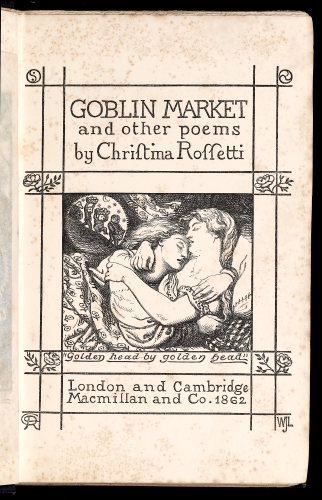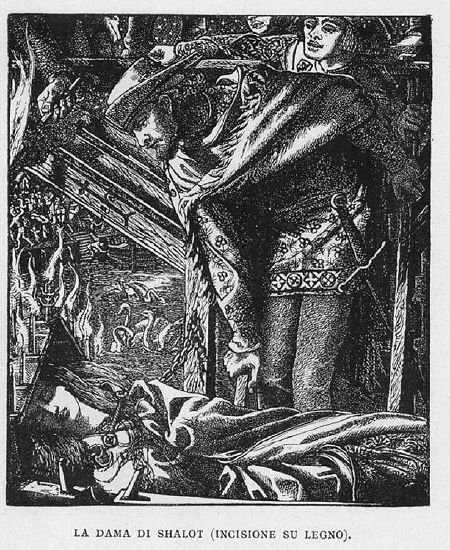From the Angel to The Fallen Woman: The Critique of Female Desire in Tennyson's "Lady of Shalott" and Christina Rosetti's "Goblin Market"
Rachel Anderson
748
The purpose of my exhibit is to create a working base of sources that touch on the undercurrents of desire and sexuality in both Christina Rossetti's "Goblin Market" and Tennyson's "Lady of Shalott". My argument is that an awakening of desire in the female protagonist of each poem is largely responsible for her fall from grace. Each woman rejects the system that is appropriate and necessary for her health and well-being in order to follow her desires and wants: Rossetti's Laura goes to the market and eats the fruit which she craves, Tennyson's Lady turns from her weaving to look out the window at Lancelot. Both women are given and ignore the warnings not to step outside their proper sphere.
Overall, a critique on the part of the poets can be found in each poem concerning the Victorian view of the ideal or proper woman, and what it means when those views no longer apply.
Overall, a critique on the part of the poets can be found in each poem concerning the Victorian view of the ideal or proper woman, and what it means when those views no longer apply.
|
This article by Marylu Hill attempts to make a connection between spirituality and sexuality in Christina Rossetti's "Goblin Market". She argues that the two concepts are not exclusive of one another within this poem (as many have argued), but rather that they work together to create a kind of unity; she argues that Laura fell in her desire to taste the goblin's fruit, and so another act of consumption is necessary to save her. This consumption takes the form of something representative of the Eucharist, but is simultaneously greatly erotic; the two are linked in an acceptable way. This article is useful to my argument because it is deeply focused on Rossetti's redemption of Laura as well as the seemingly ambiguous nature of what it means to be "fallen". Using this discussion, It could be argued that desire is responsible for Laura's downfall but is not represented as a definitive evil given its association with spirituality and Christ.
|
|
This article presents an interesting case concerning the role that female sexuality played within Victorian society. Sutphin argues that the sexuality of women was not something entirely dismissed in society, but rather it was bound within the sphere of marriage; so long as a woman was married, sexual activity was entirely acceptable as it could be disguised in the supposed necessity for creating heirs. Contrary to this, exhibiting her sexuality outside of marriage was greatly frowned upon. Sutphin has an interesting quote that I feel is relevant to my topic concerning the view of "progressive women reformers and writers" of the era (of which Rossetti could arguably be one): "fallen women and prostitutes were 'sisters' of respectable women and... the fallen could be transformed into conventional wives and mothers" (518). This seems directly applicable to Goblin Market, and shows one of the views Rossetti may have taken in her writing of the poem.
|
|
The discussion in the article centres around the expression of melancholy within Tennyson's poetic works. Riede suggests that melancholy during the Victorian era was accepted as a physical and natural thing which added weight and emphasis when expressed properly by the poet. He argues that Tennyson knowingly wove it into his works in order to add a measure of poetic authority to his work in which he often spoke with a gendered voice (female). The article strives to point out that by speaking through and by seemingly identifying with his female characters, Tennyson was able to mask his own masculine, political or imperial agenda within his poetry; the article goes so far as to suggest that he was able to indulge his masculine fantasies of female eroticism through this technique. This last piece is what I find most interesting and relevant to my argument. Applying this to "The Lady of Shalott", I would use this idea to argue that Tennyson is questioning the role female sexuality has to play in a male-dominated world.
|
|
This article provides a brief summary and critique of all the scholarly works concerning Tennyson's poetry that were published in 2001 within the Victorian Poetry journal. The article by Riede is broken down and examined in conversation with other contemporary and related works. It is mentioned here that Tennyson's earlier works focused on exotic locations (specifically the orient), topics which carried with them the inherent associations of eroticism, "otherness and femininity" (500). It is pointed out in the article that Tennyson would often indulge in scenes of fancy and exoticism early in any given poem, and then condemn it later on to reinforce the British view of masculinity. This is relevant to my argument because he does something very similar with "The Lady of Shalott": he creates a beautiful picture of the Lady in her tower, indulging in every detail of her representation as a romantic figure, and then pulls it apart when he recalls the reality of her female situation.
|
|
This image illustrates the sisterly love (bordering on eroticism) which is crucial to Laura's salvation in Goblin Market. The small detail of the goblin's in the left hand corner is largely inconsequential in the shadow of the foreground representation of the two sisters. There is nothing suggestively threatening or dangerous in this image to suggest Laura's fall from grace, and through this omission it exudes a kind of hopeful quality. The image, like the end of Rossetti's poem, suggests that one's goblins can be overshadowed and a fall can be righted. This image is useful to my argument insomuch as it seems to push Rossetti's message that fallen women can be saved.
|
|
Tennyson's Lady of Shalott falls victim to her desire; she turns away from her weaving, looks out the window to catch a glimpse of Lancelot, and begins her ultimate descent to a fallen state. Unlike in Rossetti's "Goblin Market" where Laura has Lizzie to save her, Tennyson's Lady is alone in her tower-world and has no hope for redemption when she gives into her desire. This image is a fabulous contrast to the illustration for "Goblin Market" as it shows the Lady dead in her boat, and all hope gone. In addition, this piece seems to suggest that she is unable to exist in the hard, masculine world beyond her tower (she is surrounded by stone and is being looked down upon by a knight); through desire she enters a sphere that is not her own and it consumes her. Like the image for Rossetti's text, this image mirrors the ultimate end and tone of Tennyson's poem. This is useful to my argument as it seems to suggest that fallen women can not be saved.
|
To Conclude:
Christina Rossetti's "Goblin Market" and Tennyson's "The Lady of Shalott" are comparable in that they both treat an awakening of desire as a pivotal moment of change for their female characters. On a surface level, both poets also impress the idea that women should remain in their proper sphere lest they fall victim to outside, masculine forces. The poems diverge in their critique of what it means for women to give in to desire: Tennyson suggests that once a woman has fallen she suffers a social death and moves beyond any redemption, Rossetti takes an approach that is far less bleak and hopeless by offering up the idea that salvation is possible.
Christina Rossetti's "Goblin Market" and Tennyson's "The Lady of Shalott" are comparable in that they both treat an awakening of desire as a pivotal moment of change for their female characters. On a surface level, both poets also impress the idea that women should remain in their proper sphere lest they fall victim to outside, masculine forces. The poems diverge in their critique of what it means for women to give in to desire: Tennyson suggests that once a woman has fallen she suffers a social death and moves beyond any redemption, Rossetti takes an approach that is far less bleak and hopeless by offering up the idea that salvation is possible.





